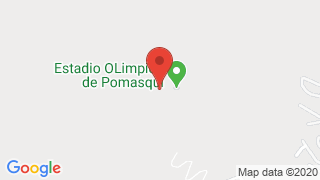Pomasqui
Pomasqui rises between the slopes of the Pacpo and Casitahua hills, North of Quito. Due to its pleasant weather, gastronomic variety and tourism activities, people really enjoy there. Let´s go to Pomasqui.







Destino de Colores - Colorful destinations of Pichincha
- The colors of Pomasqui are light blue, they are present in the sky, when the clouds settle; the red for being a town of champions and the yellow related to the wealth of this beautiful land.
- Pomasqui, Aloasí, Calacalí, Calderón, La Merced, Lloa, Mindo, Machachi, Pacto, Pedro Vicente Maldonado, Pintag, Pomasqui, are part of the Destino de Colores campaign, they are a select group of rural destinations of Pichincha province that offer to tourists a variety of tourism experiences oriented to contact with nature and culture; as well as sustainable and community tourism experiences.
- Prefectura de Pichincha, through the Destino de Colores campaign, promotes the entrepreneurial spirit of Pichincha people.
What should you know about Pomasqui?
- This unique town is located in the North of the city of Quito, just 15 minutes by car.
- Pomasqui is known as the "Valley of the beautiful temperature" for its pleasant climate that goes from 14°C to 18°C.
- There are several theories about the origin of the name of Pomasqui. One of them points out that its name comes from the combination of the Quichua words: puma and siqui, whose translation would be "seat of the puma''; and another theory says that its name is due to the fact that in this place there are large deposits of pumice stone.
- Its foundation dates back to 1573, according to several historians, it was made in honor of Santa Clara de Asís and Santa Rosa de Lima.
- Its legal foundation was on May 29th, 1861.
- This beautiful valley is crossed by the Monjas River, its presence divides Pomasqui into two zones.
- Due to its pleasant weather it is also known as the " Land of Convalescence and Longevity "
- In Pomasqui the tourist will find a wide gastronomic, cultural and tourist offer.
- Among its most popular traditional festivals are Corpus Cristi and the Lord of the Tree.
- Pomasqui is part of the Chocó Andino Biosphere Reserve.
- In Pomasqui, people still continue the tradition of the game called National Ball.
Corpus Christi
- Corpus Christi is celebrated 60 days after Easter.
- This is a catholic celebration focused on venerating the sacrifice of Jesus represented in the Eucharist.
- All Pomasqui organize in advance for almost a full year this celebration.
- The priostes are chosen to lead the celebration.
- The entire community gathers in Parque Central to enjoy traditional and cultural activities full of joy for national and international tourists.
Festivities of the Lord of the Tree
- It is considered the most popular and oldest festivity in Pomasqui.
- It is said that Caspicara himself carved the face of Jesus on a tree, which is venerated to this day.
- The entire population enjoys this festivity full of activities: dances, the traditional albazo (popular songs) on the eve, village bands and more.
Pomasqui celebration
- From June 28th to July 28th. During this festival, the art, music and traditions of the town are highlighted . Cultural, sporting and social events take place, such as the minga (community work), election of the queen, burning of the chamiza (big bonfire), town bands, fireworks, parades, bullfights and popular dances with typical characters.
Inti Raymi festivities
- The Inti Raymi is an ancient Andean celebration in honor of the sun that is carried out during the winter solstice (southern hemisphere) on June 21st of each year.
- People enjoy different cultural, sports, gastronomic activities, and other attractions that finish in the first week of every July.
Bolívar street
- It is the main street of Pomasqui , this begins at the Franciscan convent and ends at the Central Park or Yerovi park.
- In this street you will see traditional constructions, a stone sundial and a mural that stage life in the 20s. In addition, you can enjoy the paila ice cream made by the Franciscan nuns.
Central Park
- Also called Yerovi Park, this place was built with stones from local quarries. It is the space for social gathering; around it are important buildings such as the Mother church , the sanctuary and museum of the Lord of the Tree .
Mother Church of Pomasqui
- It is the symbol of the town; its neoclassical construction dates from the 16th century, however, the earthquakes that struck the area almost completely destroyed it, so it had to be rebuilt several times, the most important being in 1924.
Agave House
- Mayra Espinoza welcomes us at Casa Agave, a place dedicated to publicizing the virtues and uses of the agave.
- The agave is known as the plant of a thousand wonders since all its components are used.
- At Casa Agave there are more than 27 kinds of agaves, a wonderful plant that is used for the production of food, beverages, fiber, and material for the construction of instruments.
- Fibers for making clothes or shoes are obtained from the green agave, the popular chahuarmishqui is extracted from the blue agave, which is characterized for being a sweet drink that is produced in the ripe penco; while the yellow agave, according to Andean customs, is thought to have a connection with the moon.
- At Casa Agave the tourist can also learn about the history of the Mishqueros, who knew all the techniques to take advantage of the benefits of this plant.
Antonio Negrete Museum
- This house-museum is a unique space built in stone and decorated with river rocks and beef bones, where the works of Antonio Negrete , a specialist in the production of busts of great historical figures, are exhibited.
Lord of the Tree Sanctuary
- It is located next to the church, houses the famous sculpture of the Señor del Árbol de Pomasqui, whose body is the trunk of a kishwar (native tree) and its head was carved by the indigenous sculptor, Manuel Chili “Caspicara”.
Mirador de la Rosa Mística
- From this point you can admire volcanoes such as Cotopaxi and Cayambe , as well as a panoramic view of the Calderón and Tumbaco valleys, located north of Quito. In this place stands the chapel of the Virgen de la Rosa Mística , protector of Pomasqui .
The entrepreneurial flame is kept alive in Pomasqui
Pomasqui is the cradle of great tourist, cultural and gastronomic entrepreneurs. In this beautiful valley, tourists will find a wide offer, ready to meet all kinds of demands.
Pomas Quinde
- Rolando Luna, owner and administrator of Pomasquinde, the first urban bird watching site located in Pomasqui, welcomes us with a friendly smile.
- Rolando tells us that five years ago he began the arduous work of recovering the ravine, he tells us that "it's just a matter of a little push to help nature regenerate."
- In Pomasquinde the tourist can discover the beauty of 23 types of birds.
- These little birds have Pomasquinde as a fixed supply point on the long flight routes they make.
- In Pomasquinde the tourist can enjoy bird watching while delighting in the delicacies offered in its cafeteria.
Antonio Negrete House Museum
- In this house-museum the works of the painter and sculptor Antonio Negrete are exhibited.
- Antonio Negrete is known in the country for his great skill in carving stone.
- In this beautiful house, whose construction took about 25 years, you can find part of the pictorial and sculptural work of this virtuous and renowned artist.
- His best known works are the busts of the members of the First French Geodesic Mission.
- Works by other artists are also exhibited in the Casa Museo.
The last “alpargatero” of Pomasqui
- Don Segundo Sigcha is recognized as the last espadrille maker of Pomasqui.
- The espadrille is a handmade shoe that is part of our historical heritage.
- Don Segundo has jealousy kept this tradition and tells us that the espadrille is composed of the sole that is made of braided cabuya, the upper that can be of various designs and the heel.
- In the El Común neighborhood you can find this skilled artisan with a varied offer of colors and designs for tourists.

Publicado en:
Publicado por:




